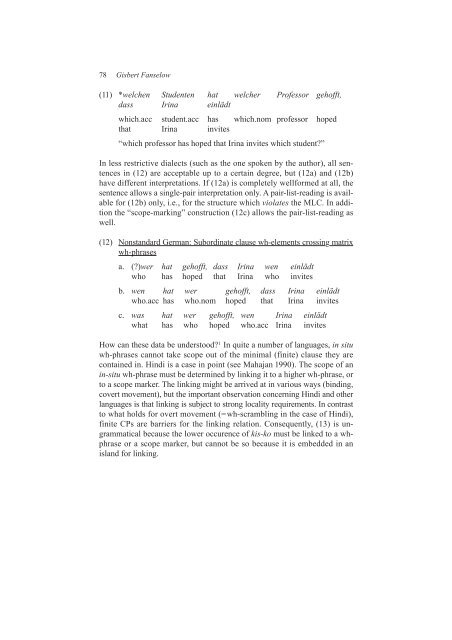Minimality Effects in Syntax · The MLC and Derivational Economy ...
Minimality Effects in Syntax · The MLC and Derivational Economy ...
Minimality Effects in Syntax · The MLC and Derivational Economy ...
Create successful ePaper yourself
Turn your PDF publications into a flip-book with our unique Google optimized e-Paper software.
78 Gisbert Fanselow<br />
(11) *welchen Studenten hat welcher Professor gehofft,<br />
dass Ir<strong>in</strong>a e<strong>in</strong>lädt<br />
which.acc student.acc has which.nom professor hoped<br />
that Ir<strong>in</strong>a <strong>in</strong>vites<br />
“which professor has hoped that Ir<strong>in</strong>a <strong>in</strong>vites which student?”<br />
In less restrictive dialects (such as the one spoken by the author), all sentences<br />
<strong>in</strong> (12) are acceptable up to a certa<strong>in</strong> degree, but (12a) <strong>and</strong> (12b)<br />
have different <strong>in</strong>terpretations. If (12a) is completely wellformed at all, the<br />
sentence allows a s<strong>in</strong>gle-pair <strong>in</strong>terpretation only. A pair-list-read<strong>in</strong>g is available<br />
for (12b) only, i.e., for the structure which violates the <strong>MLC</strong>. In addition<br />
the “scope-mark<strong>in</strong>g” construction (12c) allows the pair-list-read<strong>in</strong>g as<br />
well.<br />
(12) Nonst<strong>and</strong>ard German: Subord<strong>in</strong>ate clause wh-elements cross<strong>in</strong>g matrix<br />
wh-phrases<br />
a.(?)wer hat gehofft, dass Ir<strong>in</strong>a wen e<strong>in</strong>lädt<br />
who has hoped that Ir<strong>in</strong>a who <strong>in</strong>vites<br />
b. wen hat wer gehofft, dass Ir<strong>in</strong>a e<strong>in</strong>lädt<br />
who.acc has who.nom hoped that Ir<strong>in</strong>a <strong>in</strong>vites<br />
c. was hat wer gehofft, wen Ir<strong>in</strong>a e<strong>in</strong>lädt<br />
what has who hoped who.acc Ir<strong>in</strong>a <strong>in</strong>vites<br />
How can these data be understood? 1 In quite a number of languages, <strong>in</strong> situ<br />
wh-phrases cannot take scope out of the m<strong>in</strong>imal (f<strong>in</strong>ite) clause they are<br />
conta<strong>in</strong>ed <strong>in</strong>. H<strong>in</strong>di is a case <strong>in</strong> po<strong>in</strong>t (see Mahajan 1990). <strong>The</strong> scope of an<br />
<strong>in</strong>-situ wh-phrase must be determ<strong>in</strong>ed by l<strong>in</strong>k<strong>in</strong>g it to a higher wh-phrase, or<br />
to a scope marker. <strong>The</strong> l<strong>in</strong>k<strong>in</strong>g might be arrived at <strong>in</strong> various ways (b<strong>in</strong>d<strong>in</strong>g,<br />
covert movement), but the important observation concern<strong>in</strong>g H<strong>in</strong>di <strong>and</strong> other<br />
languages is that l<strong>in</strong>k<strong>in</strong>g is subject to strong locality requirements. In contrast<br />
to what holds for overt movement (=wh-scrambl<strong>in</strong>g <strong>in</strong> the case of H<strong>in</strong>di),<br />
f<strong>in</strong>ite CPs are barriers for the l<strong>in</strong>k<strong>in</strong>g relation. Consequently, (13) is ungrammatical<br />
because the lower occurence of kis-ko must be l<strong>in</strong>ked to a whphrase<br />
or a scope marker, but cannot be so because it is embedded <strong>in</strong> an<br />
isl<strong>and</strong> for l<strong>in</strong>k<strong>in</strong>g.
















